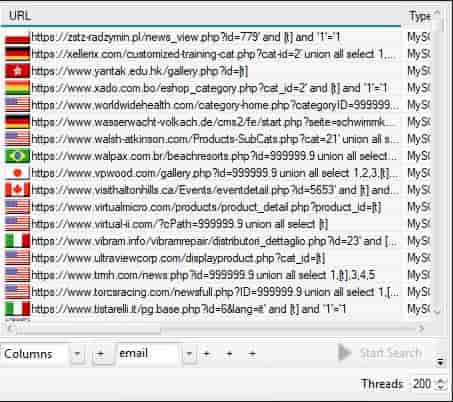

The syntax to extract the column names from the tables is the same as extracting table names except that table_name is replaced with column_name and information_lumns is used for column names. 1′ union all select 1,group_concat(column_name) from information_lumns where table_schema=database()#.We found two tables, a guestbook, and users.Įxtracting column names of the Database Table:Īfter identifying all the table names, we can enumerate list of columns in the table using the following payload: The above payload uses group_concat() function to combine all the table names in a single attribute and display the result of all tables present in the current database of information schema. 1′ union all select 1, group_concat(table_name) from information_schema.tables where table_schema=database()#.We can use union all statement to extract all table names using the following payload: The next step of our exploitation is to identify the names of all tables that exist in the database. And after 3 iterations, we got no response, which indicates that there are two columns in the database. We can iterate the order by (number) to see how many columns the database has. 1′ order by 1# // To check the number of columns using order by statement.To determine the number of columns, present in the database, we are going to use order by statement and see the response of the website.
#How to fix sqli dumper skips urls how to#
Now we know how to determine the blind sql injection in case if there is no error message but the vulnerability still exists. For example, let’s look at the following payload that executes SHA1 hash algorithm 10000000 times to delay response: Benchmark has basically two parameters, one is to define the number of rounds, and the second parameter defines the algorithm to use. Luckily, we got an alternative to the sleep () function, which can cause a delay in the response and aid in the identification of the blind sql injection attack. Sometimes, firewalls block certain features to avoid exploitation of the vulnerabilities. In case if the vulnerability doesn’t exist, we won’t be able to see the page loading for 10 seconds.ĭiscover Blind SQLi using Benchmark() function: Where sleep (10) is the function that causes the database to sleep for 10 seconds before processing anything. The following example demonstrates the purpose of sleep () function. If the vulnerability exists, the sleep function will be executed in the database, and the website will load after a certain amount of time. The payload works by making the website responding slow for the identification of the vulnerability. In such cases, the sleep() function can be used to detect blind sql injection. There are scenarios where we can’t see the output of the results on the frontend. Detecting Blind SQL Injection using Sleep function: This way, we identified the presence of blind sql injection in the website by asking true and false statements and comparing the results. Instead, it will return the left statement that is row number 1. Since 1 is not equal to 2, it will not return all the entries of the database. Now let’s check the result with the false statement.

See the following payload that always returns true statement and display entries in the database. To identify blind SQLi, we are going to make sure that the vulnerability exists in the website by asking a true or false statement. Unlike error-based SQL injection, error messages are not shown that could help in the identification of blind sql injection. To do so, we have identified the endpoint that is vulnerable to SQL injection. When exploiting the sql injection, the best first step is to identify all the user inputs which are interacting with the Database. We will exploit blind sql injection on the DVWA website (You can setup DVWA as local Pentesting lab). In this case, an attacker can take advantage of true and false statements to determine the backend database and dump data. Sometimes, the web developers hide the error messages caused by the backed SQL query, but the SQL injection vulnerability still exists in the web application due to improper handling and unsanitized user input. Extracting column names of the Database Table:.Discover Blind SQLi using Benchmark() function:.Detecting Blind SQL Injection using Sleep function:.How to Exploit Blind SQLi in a website:.


 0 kommentar(er)
0 kommentar(er)
